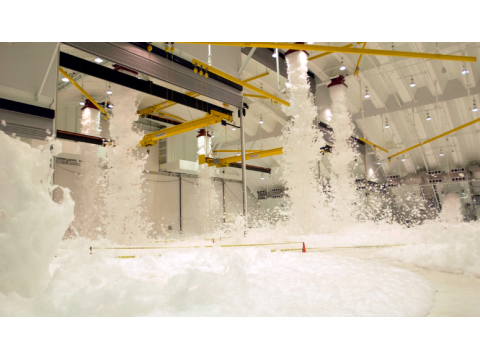Overview: Automatic Foam Fire Suppression Systems
Foam fire suppression is a versatile and cost-effective method for combating fires, especially those involving flammable and combustible liquids such as fuel, solvents, and oils. These systems are commonly used in high-risk facilities, including fuel depots, chemical plants, and transportation hubs, where water-based systems may be less effective.
Foam suppresses fires by covering the burning material, cutting off its oxygen supply, and rapidly cooling the fire source.
Key Components of Foam Fire Suppression Systems
- Pumping Stations: Include main, jockey, and backup pumps to ensure consistent foam delivery.
- Foam Generators: Combine water and foam concentrate to produce the firefighting agent.
- Piping Networks: Distribute foam to the fire zones.
- Fire Alarm System: Integrates sensors for heat, smoke, and infrared radiation.
- Control Panels: Enable local or remote operation for system activation and monitoring.
Classifications of Foam Fire Suppression Systems
1. By Foam Expansion Ratio
- Low Expansion (up to 20x): Ideal for localized fires.
- Medium Expansion (20x to 200x): Suitable for broader coverage.
- High Expansion (200x and above): Effective for volumetric suppression in large facilities.
2. By Foam Generator Type
- Venturi Tubes: Affordable but produce foam with inconsistent expansion ratios.
- Foam Tanks: Generate uniform foam but require significant space.
- Dosing Motors (e.g., Firemiks): Provide precise foam ratios but are costlier and need regular maintenance.
3. By Discharge Device
- Deluge Systems: Disperse foam across entire areas for comprehensive coverage.
- Sprinkler Systems: Localized suppression triggered by heat-activated sensors.
- High-Expansion Foam Generators (HEFG): Specialized for high-hazard zones like oil refineries and tankers.
Applications
Foam suppression systems are indispensable for facilities classified as high-risk due to fire hazards, including:
- Oil and Gas Facilities: Refineries, pipelines, and storage depots.
- Transportation Hubs: Aircraft hangars and rail yards.
- Chemical Plants: Facilities handling flammable liquids and solvents.
- Warehouses: Storage areas for fuel and combustible goods.
Advantages of Foam Fire Suppression
- Efficient Resource Use: Minimal water consumption compared to traditional systems.
- Customizable Delivery: Foam can be applied locally or across large areas.
- Non-Toxic and Safe: Foam does not harm personnel evacuating the area.
- No Need for Sealed Enclosures: Unlike gas suppression, foam systems work effectively in open spaces.
Limitations
- Unsuitable for freezing environments unless specially adapted.
- Cannot be used on live electrical equipment.
- May react with certain chemicals, worsening the fire.
Notable Foam Generators
- GPSS-600: Portable and stationary use; generates up to 600 liters of foam per second at 0.6 MPa.
- GPSS-2000: Designed for centralized systems; produces up to 2,000 liters of foam with high expansion ratios.
- Favorit HEFG: Compact hybrid generator producing foam and gas suspensions for industrial applications.
- KNP 5/10 Afrons: Chamber-type generator for vertical foam delivery, suitable for large-scale volumetric suppression.
Conclusion
Automatic foam fire suppression systems offer a robust and cost-effective solution for high-risk environments. With advancements in foam generator technology, these systems continue to evolve, providing enhanced safety and efficiency. For optimal results, consult professional designers and installers to ensure your system meets specific fire safety requirements.

